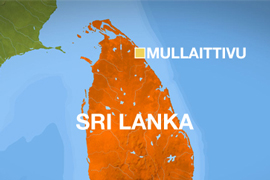Medics flee Sri Lanka fighting
Last remaining hospital in war zone evacuated after fifth attack in three days.

The hospital’s staff and 300 patients were evacuated to a coastal area deeper inside the war zone where there is no reliable source of drinking water, Sarasi Wijeratne, a spokeswoman for the ICRC, said.
Inadequate facilities
Describing the hospital’s new location in the northeast, Sophie Romanens, of the ICRC in Colombo, said: “In the new place there was no adeguate medical facility to have more than 300 patients. So some of them are staying with family if they have relatives in that area.
“But most of them are in a community centre, which is just not a place to have so many patients.
 |
“One of our colleagues described the scene inside the community centre; they said patients are lying on the ground with IV drips hanging from a tree.”
Romanens said “the medical staff are doing really fantastic job trying to take care of the patients in these very difficult conditions”.
An all-out government offensive in recent months has forced LTTE fighters from their strongholds across the north and east of Sri Lanka, driving them into a 300sq km strip of jungle along the coast.
Aid agencies say about 250,000 people are trapped in LTTE-held areas, but the government says the number is about half that.
Speaking to Al Jazeera on Thursday, Barbara Trachsel, of the aid group Caritas, said: “From what we understand, the people are withheld in the territory by the LTTE. Most of these people also have their family with them, they are part of the peoplle being withheld.
“Our workers have not been able to leave the territory either, over the last few months.”
Cluster-bombs charge
In related news, the UN said cluster munitions appeared to have hit near the Puthukudiyiruppu hospital during Wednesday’s fighting.
The previous day, up to 52 civilians were killed and dozens more injured in and around a government-designated “safe zone” – an area of LTTE territory that the government had pledged not to strike.
It is not clear which side fired the weapons.
Gordon Weiss, a UN spokesman, said 15 UN workers and 81 family members who were trapped near the hospital also fled after the area came under intense artillery fire, including what appeared to be cluster munitions.
| Focus: Sri Lanka | ||||||||

|
That was the first public accusation of the use of cluster bombs in the conflict since a ceasefire broke down three years ago, although Weiss said the weapons had been used at least once before in recent weeks.
Cluster munitions are controversial because of their ability to cause damage over a wide area.
Many of the so-called bomblets they contain do not explode immediately and pose a danger to civilians long after fighting ends.
Palitha Kohona, Sri Lanka’s minister of foreign affairs, told Al Jazeera that “Sri Lankan forces have given categorical assurances that they are not using cluster bombs, nor are they procuring them”.
Brigadier Udaya Nanayakkara, a spokesman for the military, also denied using them.
“We don’t have the facility to fire cluster munitions. We don’t have these weapons,” he said.
Weiss said the UN accepted the government’s assurances that it did not have the weapons.
Ceasefire urged
On Wednesday thousands joined protests in Geneva and Berlin against the Sri Lankan government continued offensive, demanding international intervention to stop the killing of civilians.
The US, Britain and Canada have urged both sides to agree to a temporary ceasefire to allow civilians and the wounded to leave the conflict zone and asked that humanitarian agencies – most of which were barred by the government last year – be given access.
 |
| Thousands protesting the war have demanded international intervention [Reuters] |
Speaking to Al Jazeera on Thursday, Basil Fernando, of the Asian Human Rights Commission, said: “The war is the way by which the attention of the country has been drawn away from the fundamental crises – a constitutional crisis, a legal crisis.
“An enormous crisis is [about] to unfold. There is a tremendous crisis on the way in terms of governance.”
The LTTE has been fighting since 1983 for a separate homeland for the Tamil minority that it says the Sinhalese government has marginalised.
About 70,000 people have been killed in the 26-year conflict but on Wednesday Mahinda Rajapaksa, the Sri Lankan president, told Independence Day celebrations that the government is on the verge of destroying the separatists and ending the war.
“I am confident that in a few days we will decisively defeat the terrorist force that many repeatedly kept saying was invincible,” he said.

